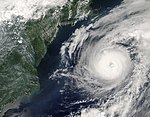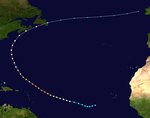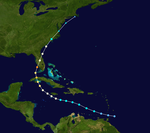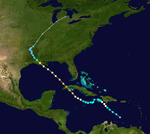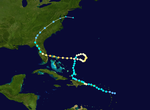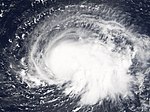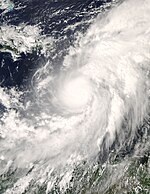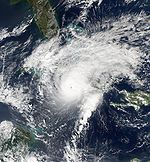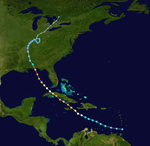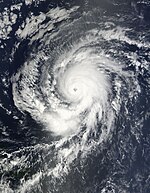User:DaBloonsplayer
| DaBloonsplayer | |
|---|---|
 Season summary map | |
| Seasonal boundaries | |
| First system formed | May 28, 2009 |
| Last system dissipated | {{{Last storm dissipated}}} |
| Strongest storm | |
| Name | Nicole - 180 mph (285 km/h), 901 mbar (hPa) [1] |
| Seasonal statistics | |
| 20 | |
| 20 | |
| Tropical cyclones | 20 |
| 15 | |
| Total fatalities | 465 direct, 102 indirect |
| Total damage | Unknown |
Hurricane Alex[edit]
| Category 3 hurricane (SSHWS) | |
| Duration | May 28 – June 6 |
|---|---|
| Peak intensity | 120 mph (195 km/h) (1-min); 957 mbar (hPa) |
The first storm of the season formed at the end of May off the coast of South Carolina. Alex strengthened into a Category 2 hurricane, and on June 3 came within 10 miles (16 km) of the Outer Banks of North Carolina without making landfall. Damage was limited to flooding and wind damage, and in Dare County, North Carolina, was estimated at $2.4 million. There were several injuries and one death reported.[2]
Alex later headed out to sea and strengthened to a Category 3 hurricane, making it only the second hurricane on record to have reached Category 3 strength north of 38° N latitude,[3] before becoming extratropical over the north Atlantic.
For the official forecasts, see the NHC's archive on Hurricane Alex.
Hurricane Bill[edit]
| Category 4 hurricane (SSHWS) | |
| Duration | June 17 – June 23 |
|---|---|
| Peak intensity | 135 mph (215 km/h) (1-min); 943 mbar (hPa) |
Late on August 12, a strong tropical wave associated with an area of low pressure moved off the African coast with deep layers of moisture observed.[4] Later that day, the wave became better organized with a low level circulation forming, but without any significant convection. That night, the area of convection became more concentrated, but wind shear increased since the previous advisory. On August 14, the disturbance strengthened more and its convective bands became stronger with better circulation, indicating that the disturbance would soon become a tropical depression. Later, on August 15, even though some of its deep convection dissipated, it was officially named Bill, the second named storm of the 2009 season. Early on August 17, an eye appeared on visible and infrared loops and Bill strengthened into a hurricane, the first of the 2009 season. Bill then briefly underwent an eyewall replacement cycle, as the eye had contracted to a half its original size. However, strengthening continued and, on the evening of August 18, Bill rapidly strengthened into a major hurricane. Bill was one of three tropical storms active on August 16. It lost tropical characteristics after making landfall on Newfoundland as a weakening Category 1 hurricane on August 24. The extratropical storm then raced eastward in the Atlantic, in open waters of the North Atlantic and later affected the United Kingdom.
Hurricane Charley[edit]
| Category 4 hurricane (SSHWS) | |
| Duration | June 29 – July 7 |
|---|---|
| Peak intensity | 150 mph (240 km/h) (1-min); 941 mbar (hPa) |
Hurricane Charley formed east of the Windward Islands on August 9 and moved rapidly west across the Caribbean. As it neared Jamaica, it became a hurricane and grazed that island on August 11, passing through the Cayman Islands the next morning. On August 12, Charley passed over mainland Cuba as a Category 3 hurricane just west of Havana.[5]
On August 13, Charley unexpectedly underwent rapid strengthening, jumping from a Category 2 to a powerful Category 4 storm in a few hours, while at the same time taking a sharp turn to the northeast. Charley made landfall as a Category 4 hurricane near Punta Gorda, Florida. Although the storm caused serious damage, much of this was limited to a narrow swath associated with the hurricane's eye wall. Charley was a very fast-moving, compact storm, and so much of its damage was attributed to high winds rather than heavy rain. Charley remained a hurricane across the entire Florida peninsula and passed through Orlando and near Daytona Beach. It later made a second landfall near North Myrtle Beach, South Carolina, on August 14. Charley dissipated near Cape Cod, Massachusetts on August 15.
Charley caused approximately $14 billion in damage to the United States, making it the fourth costliest hurricane in U.S. history. Fifteen deaths were directly attributed to Charley; four in Jamaica, one in Cuba, and ten in Florida.
For the official forecasts, see the NHC's archive on Hurricane Charley.
Hurricane Dean[edit]
| Category 5 hurricane (SSHWS) | |
| Duration | July 13 – July 23 |
|---|---|
| Peak intensity | 175 mph (280 km/h) (1-min); 905 mbar (hPa) |
A vigorous tropical wave moved off the west coast of Africa in the second week of August. It quickly organized itself and formed into a low on August 12. Tropical Depression Four formed on August 13 in the eastern Atlantic from a tropical wave to the south of Cape Verde. The depression was already exhibiting persistent deep convection, albeit confined to the western portion of its circulation due to easterly wind shear.[6] The depression was expected to strengthen significantly over the following days[6] due to abating wind shear and warming sea surface temperatures which created conditions favorable for tropical intensification.[7] The depression moved briskly westward, south of a deep layered ridge,[8] quickly escaping the easterly shear.[9]
Based on satellite images and microwave and QuikSCAT data, the depression was upgraded to Tropical Storm Dean on August 14.[10] The storm continued to strengthen overnight as it gained organization,[11] and on August 16 it was upgraded to the first hurricane of the 2007 season.[12]
On August 17 the eye of the hurricane passed into the Caribbean between the islands of Martinique and Saint Lucia as a Category 2 hurricane.[13] In the warm waters of the Caribbean, Dean rapidly strengthened into a Category 5 hurricane with 165 mph (266 km/h) sustained winds. An eyewall replacement cycle weakened Dean, which then passed just south of Jamaica as a Category 4 hurricane. [14] Dean regained Category 5 status late on August 20 and at that strength it made landfall on the Yucatán Peninsula of Mexico near Costa Maya on August 21.[14] Dean weakened to a category one storm over land.
At least 42 people have been killed by Hurricane Dean (see Impact of Hurricane Dean). None of these deaths, however, have been attributed to its first landfall, as a Category 5 hurricane, likely because the landfall brought the heaviest storm surges onto sparsely-populated lands north of Chetumal Bay, including the Sian Ka'an Biosphere Reserve.
Hurricane Emily[edit]
| Category 5 hurricane (SSHWS) | |
| Duration | July 15 – July 21 |
|---|---|
| Peak intensity | 160 mph (260 km/h) (1-min); 929 mbar (hPa) |
Emily formed from Tropical Depression Five east of the Lesser Antilles on July 11. It moved westward and hit Grenada on July 14 as a Category 1 storm. It entered the Caribbean Sea and began intensifying rapidly. It reached Category 4 intensity on July 15. Emily broke Hurricane Dennis's eight-day-old record for the most intense storm to form prior to August when it reached a minimum pressure of 929 mbar, along with 160 mph (260 km/h) winds on July 16. It was originally believed that Emily peaked at Category 4. However, some readings indicated that Emily briefly reached Category 5 strength around this time,[15] and Emily was upgraded to Category 5 status in the post-storm analysis.[16] The storm weakened slightly, however, and after passing south of Jamaica and the Cayman Islands, Emily made landfall on the Yucatán Peninsula near Tulum on the morning of July 18 as a Category 4 hurricane. Emily emerged over the Bay of Campeche and made its second landfall in rural northeast Mexico near Boca Madre, Tamaulipas as a Category 3 storm.[16]
Emily is blamed for at least fourteen deaths; one in Grenada, four in Jamaica, seven in the Caribbean and two in Mexico. The storms also caused an estimated $550 million (2005 USD) in damages, almost entirely in Grenada and the Mexican state of Quintana Roo. Some minor flooding occurred in northeastern Mexico and extreme southern Texas as a result of Emily's final landfall, but damages were light.[16]
- The NHC's archive on Hurricane Emily
Hurricane Florence[edit]
| Category 1 hurricane (SSHWS) | |
| Duration | July 24 – July 29 |
|---|---|
| Peak intensity | 90 mph (150 km/h) (1-min); 974 mbar (hPa) |
Tropical Depression Six formed from an area of low pressure midway between Africa and the Lesser Antilles on September 3.[17] Initial strengthening of the depression was slow due to shearing wind conditions. Despite the moderate to high wind shear, it strengthened enough to become Tropical Storm Florence on the morning of September 5. After becoming a tropical storm, Florence's wind field began to expand greatly; at one point tropical storm-force winds extended outward up to 450 miles (720 km) from the center. With a disorganized structure and multiple circulation centers, Florence remained a weak tropical storm for several days, even after external conditions became favorable for strengthening. Around the evening of September 8 it resolved to a single center and steady strengthening resumed.[18] On the morning of September 10, Florence reached hurricane strength. Large swells, rip tide, and undertow were reported on Bermuda, the Leeward Islands, the Virgin Islands, and Hispaniola.[19] Florence soon reached its peak as a Category 1 hurricane very near Bermuda, and became extratropical on September 12, while still a hurricane.
Hurricane Gustav[edit]
| Category 4 hurricane (SSHWS) | |
| Duration | July 30 – August 11 |
|---|---|
| Peak intensity | 155 mph (250 km/h) (1-min); 941 mbar (hPa) |
A disturbance developed in the deep tropical Atlantic in the fourth week of August. It tracked westward into the Caribbean Sea where it encountered more favorable conditions, and became a tropical depression on the morning of August 25, west of the Windward Islands. It rapidly intensified into Tropical Storm Gustav early that afternoon and into Hurricane Gustav early on August 26. Striking southwest Haiti, it weakened into a tropical storm on the evening of August 27 due to land interaction and slowed down considerably. It re-organized further south into a strong tropical storm once again on August 28 before speeding up and hitting Jamaica. Gustav has killed 85 people in Haiti, the Dominican Republic, and Jamaica, while 7 are still missing in Haiti. It then was upgraded to a hurricane again during the late afternoon of August 29. On the morning of August 30, Gustav was upgraded to a major Category 3 hurricane. After intensification slowed for a few hours, another round of rapid intensification occurred and Gustav was upgraded to a Category 4 hurricane during a hurricane hunter flight around 1 p.m. EDT (1700 UTC), with 145 mph (215 km/h) winds. Continuing to intensify, it became a 155 mph storm that afternoon before landfall. Soon after Gustav made landfall in Cuba, firstly on the island of Isla de la Juventud and later on the mainland near Los Palacios in Pinar del Río Province, causing catastrophic damage, although it was difficult to estimate it; damage was later estimated at 3 billion dollars (2008 USD). It then emerged into the Gulf of Mexico on August 30, weakening into a Category 3 hurricane with 115 mph (185 km/h) winds. However, the hurricane was still large, and early the next day, it made landfall on Louisiana. At 8 a.m. CDT September 1 the storm weakened to Category 2 just before landfall. On September 4, Gustav was absorbed by a cold front while over the Ozarks. Gustav is responsible for 153 deaths and at least $6.6 billion in damage.[20]
Hurricane Humberto[edit]
| Category 2 hurricane (SSHWS) | |
| Duration | August 11 – August 20 |
|---|---|
| Peak intensity | 105 mph (165 km/h) (1-min); 970 mbar (hPa) |
Humberto formed from an area of low pressure generated by Hurricane Gabrielle. The low formed into a tropical depression on September 21 while 425 nmi (787 km) south of Bermuda. The low tracked northwest and was named Tropical Storm Humberto the next day. It began moving north, and then northeast as it passed Bermuda and strengthened into a hurricane. Humberto headed over the colder waters of the far north Atlantic Ocean, and dissipated quickly on September 27. There were no reports of damage related to Humberto.
Hurricane Ignacio[edit]
| Category 2 hurricane (SSHWS) | |
| Duration | August 22 – August 27 |
|---|---|
| Peak intensity | 105 mph (165 km/h) (1-min); 970 mbar (hPa) |
A tropical wave organized into a distinct area of disturbed weather just south of the Mexican port of Manzanillo, Colima, on August 22 and gradually moved to the northwest. It became Tropical Depression Nine-E off Cabo Corrientes in the state of Jalisco two days later and under the influence of favorable atmospheric conditions rapidly strengthened. It was named Tropical Storm Ignacio on August 25 before it peaked as a 105 mph (165 km/h) hurricane on August 26, the first of the season. Ignacio entered the southern Gulf of California before it made landfall just to the east of La Paz, Baja California Sur. Ignacio weakened overland and dissipated early on August 28 over central Baja California.[21]
Due to the storm’s slow movement, rainfall was high and the resulting flooding was severe,[21] and Ignacio was responsible for approximately $21 million (USD) of damage.[22] Two rescue workers drowned in the flood waters brought by the storm and some 10,000 people were evacuated to shelters.[23]
- The NHC's archive on Hurricane Ignacio
- The HPC's rainfall page for Ignacio
Hurricane Jeanne[edit]
| Category 3 hurricane (SSHWS) | |
| Duration | August 28 – September 7 |
|---|---|
| Peak intensity | 120 mph (195 km/h) (1-min); 950 mbar (hPa) |
Jeanne formed as a tropical depression east-southeast of Guadeloupe on the evening of September 13. Having strengthened to a tropical storm, Jeanne crossed Puerto Rico on September 15. It then moved toward Hispaniola, barely reaching hurricane strength before making landfall on September 16. It tracked slowly across the northern coast of the Dominican Republic and Haiti, its heavy rains bringing mudslides and flooding. Jeanne's unusually slow journey was actually caused by a weakening Hurricane Ivan. Ivan broke up a trough that was fuelling Jeanne's steering currents. Interaction with Hispaniola caused it to degenerate into a tropical depression.[24]
After wreaking havoc on Hispaniola, Jeanne struggled to reorganize. However, it eventually began strengthening and headed north. After performing a complete loop over the open Atlantic, it headed westwards, strengthening into a Category 3 hurricane and passing over the islands of Great Abaco and Grand Bahama in the Bahamas on September 25. Jeanne made landfall later in the day in Florida just 2 miles (3 kilometers) from where Frances had struck 3 weeks earlier. Building on the rainfall of Frances and Ivan, Jeanne brought near-record flood levels as far north as West Virginia and New Jersey before its remnants turned east into the open Atlantic.
Jeanne is blamed for at least 3,006 deaths in Haiti with about 2,800 in Gonaïves alone, which was nearly washed away by floods and mudslides. The storm also caused 7 deaths in Puerto Rico, 18 in the Dominican Republic and at least 4 in Florida, bringing the total number of deaths to at least 3,025. Final property damage in the United States was $6.8 billion, making this the 13th costliest hurricane in U.S. history.
For official forecasts see:
- the NHC's public advisory archive on Hurricane Jeanne.
- the HPC's advisory archive on Jeanne after landfall.
Hurricane Keith[edit]
| Category 4 hurricane (SSHWS) | |
| Duration | September 1 – September 12 |
|---|---|
| Peak intensity | 140 mph (220 km/h) (1-min); 939 mbar (hPa) |
A long-lived tropical wave organized into a tropical depression while 60 nmi (110 km) north-northeast of Cape Gracias a Dios, Nicaragua on September 28. A day later it was classified as Tropical Storm Keith. Keith began to rapidly intensify as it moved slowly west, reaching Category 4 strength. Keith weakened slightly and after its eyewall passed over Ambergris Cay and Caye Caulker, Belize on October 1, it spent two days meandering off the coast of Belize. During this time it weakened dramatically and was a Category 1 hurricane when it made landfall in Belize between Belize City and Chetumal, Quintana Roo.
It passed through Belize into Campeche, and from there back into the Gulf of Mexico. After emerging over water, Keith restrengthened and was a minimal hurricane at its second landfall just north of Tampico, with a direct impact to the metropolitan city of Monterrey.
Keith is responsible for twenty-four deaths, twelve due to flooding in Nicaragua. Monetary damage in Belize is estimated at 225 million USD. No damage estimates are available for Keith's final landfall in Mexico, or for Guatemala where it caused flooding.
Hurricane Lily[edit]
| Category 4 hurricane (SSHWS) | |
| Duration | September 10 – September 17 |
|---|---|
| Peak intensity | 145 mph (230 km/h) (1-min); 938 mbar (hPa) |
Lily began on 16 September as a tropical wave moving over the Atlantic Ocean from the west coast of Africa. It developed a low level cloud circulation midway between Africa and the Lesser Antilles on 20 September. By 21 September a convective cloud system had become sufficiently organized to classify the system as a tropical depression about 900 nautical miles (1,700 km) east of the Windward Islands.
By 23 September the storm had crossed the Windward Islands as a developing tropical storm before weakening back to a tropical wave on the 25 September when it was disrupted by vertical wind shear. On 28 September a low level circulation had reformed proceeding along the north coast of Jamaica, dumping heavy rains on both Jamaica and Haiti.
On 30 September Lily became a hurricane while passing over the Cayman Islands. By 1 October the center of the hurricane had moved western mainland Cuba gradually accelerating its forward speed before turning northward, attaining Category 4 status in the Gulf of Mexico before making landfall on the Louisiana coast on 3 October. On 4 October Hurricane Lily was absorbed by an extra tropical low whilst moving north-eastward near the Tennessee/Arkansas border.
Lily was the first hurricane to make landfall in the United States since Hurricane Irene in 1999. Despite weakening greatly before landfall (only a 90 mph storm), Lily still caused 13 deaths and almost a billion dollars of damage.
Hurricane Mark[edit]
| Category 1 hurricane (SSHWS) | |
| Duration | September 15 – September 20 |
|---|---|
| Peak intensity | 90 mph (150 km/h) (1-min); 979 mbar (hPa) |
A well-defined low pressure system located about 350 statute miles (560 km) south-southwest of Bermuda organized into a tropical depression on September 5. It strengthened into Tropical Storm Mark that evening and continued to strengthen with little change in position, becoming the sixth hurricane of the season on September 7.[25]
Hurricane Mark passed 125 statute miles (200 km) south of Bermuda on September 8 and reached peak intensity of 90 mph (145 km/h). Mark then began to weaken. After turning north, it became extratropical over the central Atlantic Ocean on September 10.[26]
Hurricane Nicole[edit]
| Category 5 hurricane (SSHWS) | |
| Duration | September 21 – September 29 |
|---|---|
| Peak intensity | 180 mph (285 km/h) (1-min); 901 mbar (hPa) |
A tropical wave moved off the coast of Africa on September 1, which developed into Tropical Depression Fourteen early on September 6 to the southwest of the Cape Verde islands. It quickly intensified into Tropical Storm Nicole,[27] and it continued to gradually intensify within an area of light wind shear and warm waters.[28] Nicole strengthened to a hurricane on September 7, and the following day it attained major hurricane status. Its intensity fluctuated over the subsequent days as it passed north of the Lesser Antilles, and it attained peak winds of 145 knots (270 km/h) on September 11, a Category 5 hurricane on the Saffir-Simpson Scale. The hurricane oscillated between Category 4 and Category 5 status over the following four days, before weakening due to wind shear. On September 18 Nicole made landfall between Cape Lookout and Ocracoke Island in North Carolina with winds of 105 mph (165 km/h). It continued northwestward, becoming extratropical over western Pennsylvania before being absorbed by a larger storm over Ontario on September 19.[27]
Strong winds from Nicole extended from North Carolina to New England and westward to West Virginia. The winds, combined with previous rainfall which moistened the soil, downed many trees and power lines across its path, leaving about 6 million electricity customers without power at some point. Coastal areas suffered from waves and its powerful storm surge, with areas in eastern North Carolina and southeast Virginia reporting severe damage from both winds and the storm surge. Throughout its path, Isabel resulted in $3.6 billion in damage (2003 USD, $4.04 billion 2007 USD) and 47 deaths, of which 16 were directly related to the storm's effects.[29]
The governors of Pennsylvania, West Virginia, Maryland, New Jersey, and Delaware declared states of emergencies.[30] Nicole was the first major hurricane to threaten the Mid-Atlantic States and the South since Hurricane Floyd in September 1999. Nicole's greatest impact was due to flood damage, the worst in some areas of Virginia since 1972's Hurricane Agnes. More than 60 million people were affected to some degree — a similar number to Floyd but more than any other hurricane in recent memory.[31]
Hurricane Omar[edit]
| Category 4 hurricane (SSHWS) | |
| Duration | October 1 – October 6 |
|---|---|
| Peak intensity | 135 mph (215 km/h) (1-min); 958 mbar (hPa) |
A tropical disturbance in the eastern Caribbean Sea was in an area unfavorable for development in the second week of October. While drifting across the region, upper-level winds diminished enough for the tropical disturbance to strengthen and to develop into Tropical Depression Fifteen on October 13. It strengthened to Tropical Storm Omar the next day. Omar quickly strengthened into a 70 mph (110 km/h) storm that afternoon, and became a hurricane that night. It remained a hurricane through that night and it changed little in intensity through the next day, but that evening Omar intensified quickly and became a 115 mph Category 3 storm, and became a 125 mph (205 km/h) storm the next morning. In a discussion supplied by the National Hurricane Center, it stated that Omar may have peaked as a minimal Category 4 early that morning. This was later confirmed in November in their Running Best Track.[32] However, wind shear and dry air quickly weakened Omar to a minimal hurricane that afternoon as it raced towards the northeast at 26 mph (41 km/h), and soon it dropped to tropical storm strength. It then degenerated to a remnant low the next day. Omar caused at least $60 million in damage to the Lesser Antillies (2008 USD), and killed 2 people, both in Puerto Rico.
Hurricane Paloma[edit]
| Category 4 hurricane (SSHWS) | |
| Duration | October 5 – October 10 |
|---|---|
| Peak intensity | 145 mph (230 km/h) (1-min); 944 mbar (hPa) |
An area of low pressure became stationary in the Caribbean Sea without showing tropical development for several days at the beginning of November. Finally, on November 5 the low pressure system organized and became Tropical Depression Sixteen just east of Nicaragua. The next day it strengthened to become Tropical Storm Paloma then later, Hurricane Paloma. The following days proved to be a rarity in terms of tropical cyclone intensity in the month of November. This was seen when Paloma was upgraded to a Category 2, then later a Category 3 major hurricane, making it the first P named storm to reach major hurricane status in the Atlantic Basin. Paloma continued to strengthen and peaked with winds of 145 mph, making it the second strongest November hurricane behind 1999's Lenny, by the afternoon of the 8th, but Paloma weakened rapidly before making landfall as a Category 2 hurricane on the evening of November 8 near Santa Cruz del Sur, Cuba. On November 9, Paloma was downgraded to a tropical storm and then a depression. Later that evening, the storm finally met its demise as it transformed into a remnant low. Paloma caused up to $300 million (2008 USD) in damage to Cuba, and $15 million in damage to the Cayman Islands. In the spring of 2009 the WMO retired the name Paloma, making it the first retired P named storm in the Atlantic Basin.
Hurricane Rita[edit]
| Category 5 hurricane (SSHWS) | |
| Duration | October 11 – October 21 |
|---|---|
| Peak intensity | 180 mph (285 km/h) (1-min); 895 mbar (hPa) |
The season's seventeenth tropical depression formed over the Turks and Caicos Islands on September 18. Later that day, it became the seventeenth tropical storm of the season. Rita slowly intensified to become a hurricane on September 20. It was at Category 1 and later Category 2 intensity as it moved south of the Florida Keys. Rapid intensification ensued as Rita moved into the Gulf of Mexico on September 20, and Rita became a Category 5 hurricane on September 21, becoming at the time the third-most intense hurricane ever recorded in the Atlantic Basin with a minimum central pressure of 897 mbar, though it would later fall to fourth following Hurricane Wilma. However, as the storm moved slowly across the Gulf of Mexico it gradually weakened until landfall. Rita made landfall as a weak Category 3 hurricane in Cameron Parish, Louisiana near the Texas/Louisiana border on September 24, 2005.[33]
Major flooding was reported in Port Arthur and Beaumont. Cameron and Calcasieu Parishes in Louisiana were also devastated. Offshore oil platforms throughout Rita's path also suffered significant damage, though the refineries of Houston, originally thought to be at risk, escaped the brunt of the storm. Seven people are confirmed dead from Rita's direct effects, and total damage from the storm is estimated at $10 billion, almost entirely in Texas and Louisiana. 55-112 indirect deaths have also been reported, most resulting from incidents during the evacuation of Houston when the storm was predicted to strike the city. Many of the indirect deaths were caused by a single bus fire in the mass exodus.[33]
- The NHC's archive on Hurricane Rita
- The HPC's archive on Hurricane Rita
Hurricane Stan[edit]
| Category 1 hurricane (SSHWS) | |
| Duration | October 15 – October 25 |
|---|---|
| Peak intensity | 80 mph (130 km/h) (1-min); 977 mbar (hPa) |
A tropical wave in the western Caribbean Sea organized into Tropical Depression Eighteen on October 1. Off the coast of the Yucatán Peninsula, it strengthened into Tropical Storm Stan on October 2. Stan made landfall on the Yucatán and weakened to a tropical depression, but upon reemerging into the Bay of Campeche it quickly strengthened into a hurricane on October 4. Stan made landfall later that morning on the east-central coast of Mexico, south of Veracruz, as a Category 1 hurricane.[34]
Stan was associated with a large area of loosely-organized but very heavy shower activity existing over Mexico and Central America during this time. Torrential rainfall in this area caused catastrophic flooding and mudslides which were responsible for at least 1,662 deaths in six countries; 1,500 of these casualties occurred in Guatemala alone. Initially, more than a thousand deaths were attributed to Hurricane Stan, but the National Hurricane Center postulates that all but less than 100 of the deaths were more related to the larger weather event. This was not definitively confirmed in the Tropical Cyclone Report for Hurricane Stan, though it is certain that only 80-100 deaths resulted from the direct effects of the hurricane.[34]
In addition to the large number of people killed during this time, over 100,000 people were forced to evacuate. The eruption of the Santa Ana Volcano on October 1 contributed to the destruction in Central America as a result of the floods and mudslides caused.[34]
- The NHC's archive on Hurricane Stan
Hurricane Teresa[edit]
| Category 4 hurricane (SSHWS) | |
| Duration | October 15 – October 22 |
|---|---|
| Peak intensity | 145 mph (230 km/h) (1-min); 935 mbar (hPa) |
Hurricane Teresa developed out of a broad area of low pressure several that formed hundred miles southwest of Baja California Sur on August 3, developing into Tropical Depression Nineteen the next day, shortly after Tropical Depression Eighteen formed directly to the east. It strengthened into a tropical storm and was named Teresa early on August 4. It rapidly strengthened that morning as an eyewall quickly developed, the rapid intensification being attributed to warm water along the forecast track, which allowed for more rapid intensification. Teresa continued to intensify and became a hurricane that afternoon. Rapid intensification continued into that evening, and the NHC upgraded Felicia to a Category 2 hurricane. It continued to rapidly strengthen, becoming the first major hurricane of the season on the morning of August 5, when the NHC upgraded it to a Category 3 hurricane. Later that day, Teresa rapidly intensified to a Category 4 hurricane, with maximum winds increasing to 145 mph (230 km/h), making it the strongest storm in the Eastern Pacific since Daniel in 2006. The NHC predicted that Teresa would rapidly weaken during the next couple of days starting on August 6, but it was also noted by the NHC that Teresa was displaying annular hurricane characteristics, which would allow for it to maintain intensity for longer than expected over marginal SSTS.
On August 8 it crossed into the Central Pacific basin, gradually weakening to a tropical storm and then a tropical depression as it approached the Hawaiian Islands. Tropical storm and flash flood watches were issued on August 7 for the Big Island of Hawaii and Maui County, and were extended to include Oahu on August 9. The watches for the Big Island were later canceled as the track for Teresa appeared to turn toward the north. All watches were canceled at 11 a.m. HST August 11 as Teresa dissipated to a remnant low.[35]
Hurricane Ulysses[edit]
| Category 3 hurricane (SSHWS) | |
| Duration | October 20 – October 25 |
|---|---|
| Peak intensity | 120 mph (195 km/h) (1-min); 958 mbar (hPa) |
Tropical Depression Twenty formed from a tropical wave south of Cape Verde on September 7. It strengthened later that day to become Tropical Storm Ulysses. Early the next day, under favorable conditions, Ulysses strengthened to a Category 1 hurricane and was expected to intensify further. Ulysses rapidly intensified through the evening and into the early morning hours, becoming a Category 2 hurricane just six hours after becoming a hurricane. It continued to strengthen into a second major hurricane that morning, becoming the strongest storm ever recorded so far south and east in the Atlantic basin in the satellite era, and only the third major hurricane on record east of 35°W.[36] Ulysses weakened soon afterwards due to vertical wind shear, and devolved into a remnant low on September 12. [37] On September 20 Ulysses's remnant low nearly dissipated southwest of Bermuda. [38] The remnant low persisted until moving over the southeastern United States. The remnant low was the main cause of the 2009 Georgia floods. The floods left 10 fatalities and $500 million in damage. [39]
- ^ "Best Track for Hurricane Bill (03L)". National Oceanic and Atmospheric Administration. 2009. Retrieved August 19, 2009.
- ^ National Hurricane Center (2004). "Tropical Cyclone Report: Hurricane Alex". NOAA. Retrieved 2006-03-18.
- ^ Stacy Stewart (2004). "Hurricane Alex Discussion Number Nineteen". National Hurricane Center. Retrieved 2006-05-22.
- ^ Walton (2009-08-13). "Tropical weather discussion 205 AM EDT August 13 2009". National Hurricane Center. Archived from the original on 2009-08-22. Retrieved 2009-08-16.
{{cite web}}: Unknown parameter|deadurl=ignored (|url-status=suggested) (help) - ^ National Hurricane Center (2004). "Tropical Cyclone Report: Hurricane Charley". NOAA. Retrieved 2006-03-18.
- ^ a b Knabb (2007). "Tropical Depression Four Discussion One". National Hurricane Center. Retrieved 2007-08-14.
- ^ Knabb (2007). "Tropical Depression Four Discussion Two". National Hurricane Center. Retrieved 2007-08-14.
- ^ Brown/Franklin (2007). "Tropical Depression Four Discussion Three". National Hurricane Center. Retrieved 2007-08-14.
- ^ Rhome (2007). "Tropical Depression Four Discussion Four". National Hurricane Center. Retrieved 2007-08-14.
- ^ Avila (2007). "Tropical Storm Dean Discussion Five". National Hurricane Center. Retrieved 2007-08-14.
- ^ Beven (2007). "Tropical Storm Dean Discussion Eight". National Hurricane Center. Retrieved 2007-08-15.
- ^ Beven (2007). "Tropical Storm Dean Discussion Twelve". National Hurricane Center. Retrieved 2007-08-16.
- ^ Avila (2007). "Hurricane Dean Discussion Seventeen". National Hurricane Center. Retrieved 2007-08-17.
- ^ a b Franklin (2008). "Tropical Cyclone Report, Hurricane Dean" (PDF). National Hurricane Center. Retrieved 2008-02-01.
- ^ The July 17 5 a.m. EDT Discussion (#26) for Hurricane Emily, National Hurricane Center
- ^ a b c National Hurricane Center (2006). "Tropical Cyclone Report: Hurricane Emily" (PDF). NOAA. Retrieved 2006-03-13.
- ^ Jack Beven (2006). "Hurricane Florence Tropical Cyclone Report" (PDF). National Hurricane Center. Retrieved 2007-06-06.
- ^ National Hurricane Center. "Discussion for Tropical Storm Florence, 11:00 a.m. EDT, Sept. 8, 2006". NOAA. Retrieved 2006-09-09.
- ^ Associated Press. "Bermuda braces as Florence becomes hurricane". CNN.
- ^ Jindal,, Landrieu Urge Congress Aid For Hurricanes Gustav, Ike
- ^ a b National Hurricane Center (2003). "Tropical Cyclone Report: Hurricane Ignacio". National Oceanic and Atmospheric Administration. Retrieved 2006-08-09.
- ^ Foro Consultivo Cientifico y Technológio (2005). "Desastres mayores registrados en México de 1980 a 2003" (PDF) (in Spanish). p. 20. Retrieved 2006-08-10.
- ^ Staff Writer (2003-08-25). "Hurricane Ignacio forces 10,000 to take shelter". Agence France-Presse. Retrieved 2006-08-09.
{{cite news}}: Check date values in:|date=(help) - ^ National Hurricane Center (2004). "Tropical Cyclone Report: Hurricane Jeanne". NOAA. Retrieved 2006-03-18.
- ^ National Hurricane Center (2005). "Tropical Cyclone Report: Hurricane Mark" (PDF). NOAA. Retrieved 2006-02-14.
- ^ Cite error: The named reference
NateTCRwas invoked but never defined (see the help page). - ^ a b Jack Beven & Hugh Cobb (2003). "Hurricane Nicole Tropical Cyclone Report". National Hurricane Center. Retrieved 2007-12-19.
- ^ Avila (2003). "Tropical Storm Nicole Discussion Two". NHC. Retrieved 2006-10-27.
- ^ United States Department of Commerce (2004). "Service Assessment of Hurricane Nicole" (PDF). NOAA. Retrieved 2007-02-10.
- ^ Scotsman.com (2003). "America feels the wrath of Nicole". Retrieved 2007-02-11.
- ^ National Climatic Data Center (2003). "Climate of 2003- Comparison of Hurricanes Floyd, Hugo and Nicole". Retrieved 2007-02-11.
- ^ ftp://ftp.tpc.ncep.noaa.gov/atcf/tcweb/invest_al152008.invest
- ^ a b National Hurricane Center (2006). "Tropical Cyclone Report: Hurricane Rita" (PDF). NOAA. Retrieved 2006-03-17.
- ^ a b c National Hurricane Center (2006). "Tropical Cyclone Report: Hurricane Stan" (PDF). NOAA. Retrieved 2006-02-14.
- ^ Knabb (August 11, 2009). "Tropical Depression Felicia Public Advisory 33". Central Pacific Hurricane Center. Retrieved August 11, 2009.
- ^ HURRICANE FRED DISCUSSION NUMBER 8, National Hurricane Center, 1100 AM AST WED SEP 09 2009. Accessed 2009-09-10. Archived 2009-09-12.
- ^ "Tropical Depression FRED Public Advisory". Archived from the original on 2009-09-16. Retrieved 2009-09-12.
{{cite web}}: Unknown parameter|deadurl=ignored (|url-status=suggested) (help) - ^ Brown, Daniel (20 September 2009). "Graphical Tropical Weather Outlook". National Hurricane Center. Retrieved 2009-09-22.
- ^ http://www.examiner.com/x-3958-Atlanta-Northside-Family--Parenting-Examiner~y2009m9d27-Atlanta-flood-update-2-Damages-doubled-more-counties-declared-disaster-areas

